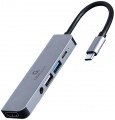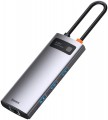USB А
The number of USB inputs located on the case of the card reader or hub (see "Type"). The number of USB ports that you will have at your disposal after connecting the device depends on this parameter. "Pure" card readers and combined models, usually, have 1,
2 and even
3 USB inputs, while hubs have
4 or more ports.
USB A version
This paragraph refers to the USB connector interface. The main difference between the interface versions is speed. It is worth noting that the speed of the input connector does not yet indicate the overall throughput, since the simultaneous connection of
flash drives,
phones, memory cards slows down data transfer, which anyway is limited by the interface for connecting the device itself to a PC or
laptop(item "Connection interface").
- USB 2.0. The outdated version 2.0 provides data transfer rates up to 480 Mbps. Found only in USB A ports.
- USB 3.2 gen1. The previous names of the USB 3.1 gen1 and USB 3.0 standard (they know how to confuse). This version provides 10 times the maximum speed (4.8Gbps) as well as higher power supply, which allows you to connect power-hungry devices and large splitters.
- USB 3.2 gen2. Further improvement of the USB 3.2 gen1 standard (and, as is customary, the previous name USB 3.1 gen1 and simply USB 3.1, which was renamed more than once), made it possible to achieve a maximum speed of 10 Gbps and even higher power for external devices.
mini-Jack (3.5 mm)
The presence of a classic
3.5 mm Aux line port for audio transmission allows you to connect headphones or a speaker to the device.
LAN (RJ-45)
The presence
of a LAN connector (RJ-45) makes it possible for the card reader/hub to work as a LAN adapter.
This port is commonly used for wired connection to computer networks. This connection may be preferable to wireless in some situations, but some devices (such as ultra-thin laptops) may not have a native LAN port. And in a PC, where such a port is usually installed on the back of the case, it can be much more difficult to get to it than to the USB connector. For such cases, card readers / hubs with a built-in LAN adapter are designed — usually, these are external devices connected via USB and capable of operating as an external network card.
Power Delivery
The technology allows you to work at higher voltage, thereby increasing the transmitted power.
USB hubs with Power Dlivery can not only charge smartphones faster, but also power more power-hungry devices, such as laptops.
Cable length
The length of the cable supplied with the device. Mostly relevant for models with a non-removable cable that cannot be replaced.
Activity indicator
Light indicator, indicating that data is currently being exchanged between the memory card and the computer to which the card reader is connected. This allows you to avoid disconnecting the card reader during operation, which is fraught not only with data loss, but even damage to the device.

